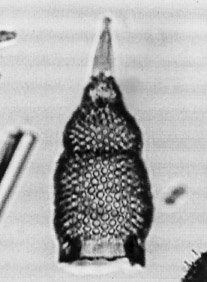 Theocotyle
nigriniae Riedel and Sanfilippo
Theocotyle
nigriniae Riedel and Sanfilippo Theocotyle
nigriniae Riedel and Sanfilippo
Theocotyle
nigriniae Riedel and SanfilippoTheocotyle cryptocephala(?) nigriniae Riedel and Sanfilippo, 1970, p.525, pl.6, fig.5 (non 6); Sanfilippo and Riedel, 1982, p.178, pl.2, figs.1-3 (with synonymy)
Subcylindrical in general form. Cephalis large for a theoperid, moderately porous, bearing conical horn of usually 2-3 times its length. Thorax campanulate, approximately as wide as abdomen, usually with three short wings. Lumbar stricture distinct. Abdomen subcylindrical, often puckered medially, with pores of approximately same size as those of thorax, and showing some irregularity in size and some tendency to longitudinal alignment. Peristome long and usually not pronouncedly thickened, with external contour not strongly tapering distally. In many specimens, abdominal pores irregularly transgress onto proximal part of peristome. Peristomial margin usually with tiny, irregular thorns terminally, and some early specimens with three short, broad, footlike extensions (Sanfilippo and Riedel, 1982).
Based on 25 specimens. Maximum length excluding horn 140-210 µm, of abdomen 65-140 µm. Maximum width 80-115 µm (Sanfilippo and Riedel, 1982).
Theocotylissa auctor differs from Theocotyle nigriniae by its more robust horn and three distinct feet. T. cryptocephala differs by having an inflated, rather than subcylindrical, abdomen, with larger pores tending to be more regularly arranged (Sanfilippo et al., 1985).
The thorax is constantly campanulate, and usually bears three short wings. The subcylindrical abdomen is much more variable, usually longer than the thorax but commonly shorter in early specimens. When the abdomen is long, it is commonly slightly puckered medially and the pores there tend to be less regular. The hyaline, bandlike peristome is a little thickened in some specimens, and usually bears tiny, irregular thorns terminally. There is no marked change in contour where the peristome joins the abdomen, and the abdominal pores irregularly transgress onto the proximal part of the peristome. The typical forms [length (excluding horn) 110-205 µm; of abdomen 65-140 µm; maximum breadth 70-125 µm] are accompanied in many assemblages by markedly smaller ones [length (excluding horn) 85-140 µm; length of abdomen 25-70 µm; maximum breadth 60-90 µm]. These small forms are often closed basally by a transverse lattice-plate, and range higher stratigraphically than forms with the typical morphology (which become sparse in and above the Theocotyle cryptocephala Zone) (Sanfilippo et al., 1985).
This species is found in considerable numbers in samples of middle early to early middle Eocene age from the tropics. Its morphotypic first appearance is approximately synchronous with the lower limit of the Buryella clinata Zone. Its evolutionary transition to Theocotyle cryptocephala defines the base of the Theocotyle cryptocephala Zone, but its morphotypic last appearance lies within the Thyrsocyrtis triacantha Zone.
T. nigriniae possibly originated from Theocotylissa auctor by loss of the three feet, and evolved into Theocotyle cryptocephala by the peristome becoming thick, thornless and marked off from the abdomen by a change in contour.
Additional illustrations can be found in Cita et al., 1970, pl.2, fig.L.